As the COVID-19 pandemic has continued along its way through the world, our community has responded as it always does, by designing and making things intended to solve the problems thrown up by the situation we find ourselves in. Much of this effort has gone into the production of PPE to plug the gap and many essential staff have been protected by maker-provided equipment, while the remainder of the effort has produced a wide array of clever designs for COVID-related items.
With curves flattened in many areas, Governments around the world are now encouraging the wearing of face masks in everyday social interactions. The purpose of mask for the general public is for droplet catching rather than virus filtering, and home made masks easily accomplish this. So let’s take a look at what you need to know about making a mast of your very own.
Now Is The Time To Talk About Making PPE
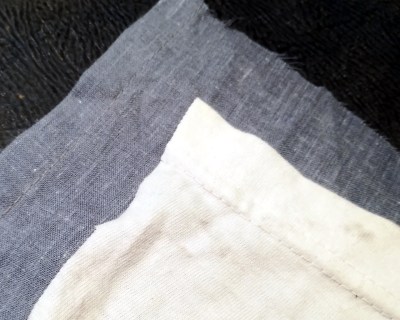
In the first part of this series I took an overview of how the requirements for a general public mask are different to those of a mask for medical staff, and examined a few commercially-available options. We will now examine together the materials and construction of home-made masks.
In the past I’ve looked at sewing machines and the textilist’s bench in detail, but for mask making you should be good to go with almost any sewing machine, a sharp pair of fabric shears, and maybe some pins to make your life easier. I want our community to come through all this in good shape, so I invite you to join me at the sewing machine. You could make a Government-sanctioned simple no-sew variety, but for use over the coming months there’s no substitute for a sew mask.
Before anything else when considering a mask, we must start with the choice of fabric. It is important that whatever layers your mask contains must be both effective filters and be safe to breathe through. Whatever air passes through it will end up in your lungs, so as you can probably imagine there will be unsuitable materials that can give you significant problems. In particular some non-woven cloths are not designed as filters and will shed fibres, and some materials may contain mineral or harmful chemical components. A commonly touted idea for example is that a vacuum cleaner bag makes a suitable material based upon its filtering ability, however since there are vacuum cleaner bags whose paper contains fungicide as well as other harmful substances it would be difficult to ascertain whether your bag is safe to breathe through. We covered some research back in March that looked at the effectiveness of a variety of materials, and for the purposes of this article we’ll be going with their conclusion of a two-layer design featuring cotton-T-shirt fabric and cotton bed linen.
Making The Many Masks
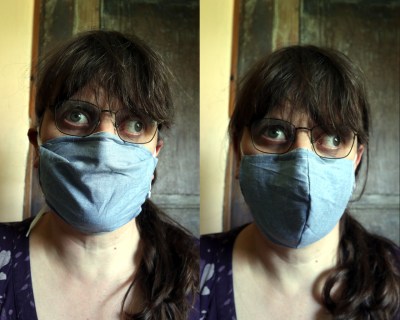
There are a variety of mask designs to be found, but they all fall into two broad streams of pleated “surgical” style or a more fitted style with a seam down the middle. The style you pick is a matter of personal preference.
Of the two I found the pleated design to be easier to make but less stylish, and the fitted style to be difficult to get right but worth persevering — once you nail the dimensions you can made several to have on hand.
The patterns I used were the HK Mask which was the first fitted mask I tried, Tanya Fish’s pattern with instructions, and a pattern for a pleated mask from SleepPhones to which I have made a few modifications.
Pattern Behavior
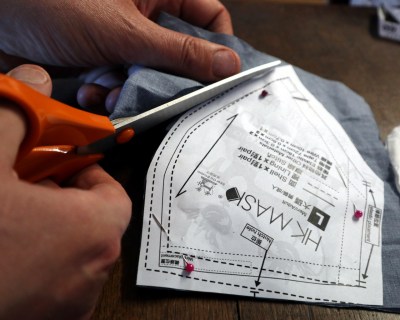
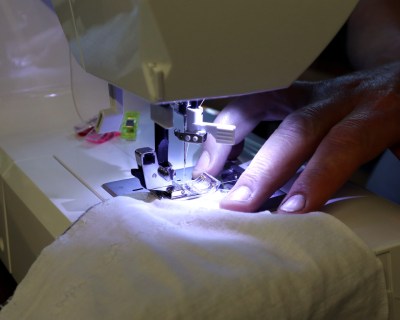
The first step is printing out the pattern to size and pinning it to your material. For the fitted mask you then sew together the two pattern pieces for each layer, with the pleated mask you simply cut out a rectangle of material. From there, sew the layers together as an inside-out bag along three seams integrating whatever nose stiffener you are using into the top seam.
Making The Turn and Securing the Straps

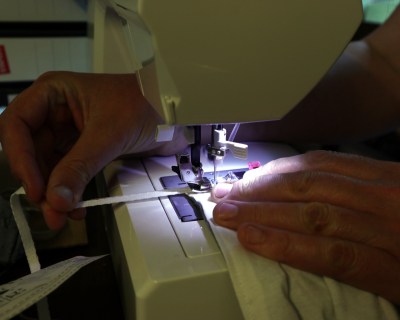
We left the fourth edge open so that you can turn the bag the right way out. The remaining seam can now be top-stitched. It’s best to follow the instructions with whatever design you choose, but once you have made more than a couple you’ll get the feel for it and be able to modify the pattern as you see fit.
On commercial masks the ties are universally elastic, and hook over the ears or round the head. At times during the pandemic there has been a shortage of elastic, so in its place I have used trainer laces. You can also try making your own bias tape with a 3D-pinted folding device and your sewing machine, or saving the elastic from disposable masks if you have any. The elastic can be incorporated into the side seams as you sew them, or in the case of trainer laces their half-way point can be laid over the centre of the side seam or pleated area and they can be sewn onto the surface of the fabric.
Fitting Around Your Nose and Adding Some Style to Your Mask
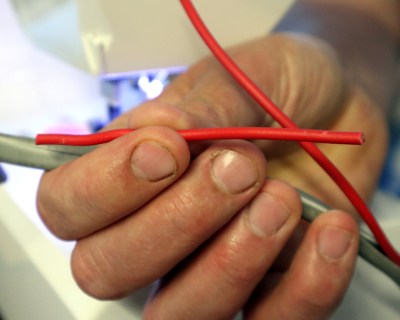
The nose wire can be almost anything stiff but flexible enough to bend, that will survive being washed. Pipe cleaners and gardening wire have been used, I tried a cable tie which wasn’t stiff enough, in the end I settled for a single insulated copper conductor from UK house wiring cable. I suggest you try a few for ease of bending before you commit to one.
These masks aren’t sterile medical devices, but they should be cleaned regularly. There must be any number of ways to sterilise them, but I am not going quite that far. Instead, since the advice is that the COVID-19 virus has a shell that is susceptible to soaps, I am washing my masks in the washing machine with the rest of my laundry.
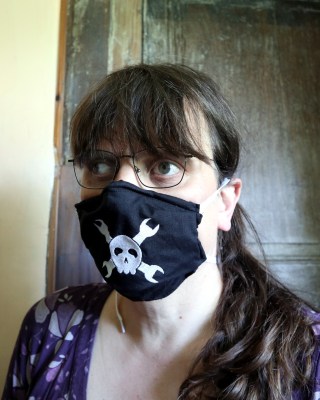
Finally, with the pleated masks there are two ways that they can be folded. The first is as a series of short panels folded in one direction, but there is another one using a box pleat, a larger flat area with smaller pleats in opposing directions. It makes little difference to the wearer, but the latter style makes for better display of any logo or pattern on the fabric.
In particular last October at the eth0 event in the Netherlands I was lucky enough to have a friend use a Brother embroidery machine to put a Wrencher on a piece of linen dress fabric. It’s sat in my textile box ever since, and a Wrencher mask with the logo arranged at the centre of the box pleat is the perfect use for it. I’m sorry that it’s a one-off, but perhaps it will give you ideas should you know anyone with a similar embroidery machine.
I hope that the two parts so far of this series have filled any gaps in your knowledge about face masks, and have equipped you with everything you need to set about making your own. There’s one further part to come in this series on surviving the pandemic as a hacker, and this time it’s not to do with the virus itself. The lockdown and quarantine is a once-in-a-lifetime upheaval for most of us, and that will have an effect on people in itself. We’ll be looking at the mental health aspects of surviving it, and how to come out the other side with as few scars as possible.















https://robots-everywhere.com/re_wiki/pub/web/Cookbook.SaltMask.html We did this at the time (March), figuring that it would become an issue.
I hadn’t heard of a salt filter, I can see adding one to a cloth mask (staples?) would be a good idea.
This article is a spoof, right?
Whether you do or don’t believe a mask may be useful to prevent droplet transmission (and I do), this article’s also
useful for anyone who wants to make their own mask for other activities where dust or similar is an issue. e.g. clearing out a loft with old degraded fibreglass insulation, mountain biking down a dusty trail, cutting holes in plasterboard/drywall to lay cables. Why would you think it was a spoof?
Especially as, with the pandemic in progress, evryone has been out buying the masks, and anything sort of similar to a mask, so there aren’t many left on the shelves to buy for anything you might need a mask for.
I wish.
It’s written from the UK, a country where COVID-19 hasn’t been well managed at all. The current advice at last is to wear masks when going out, and they’re mandatory on public transport.
They’re not a panacea. But they’re all the Average Joe has when it comes to reducing the passage of droplets. Everyone has the freedom to do what they like, I’m taking my freedom to protect myself as best I can.
I made both fitted and pleated masks. I find that in both cases the weak point is the nose fit: while I think most of the air comes in through the mask (the mask nicely seals around the nose and mouth when I inhale), I can feel a part of the exhalation coming out along the nose, even on a fitted mask that feels like it has good fit. Any suggestions? (On my fitted mask, I’m using an insulated house wire, too.)
I’ve ordered a 3M P100 half-mask which should avoid this problem once I block its exhaust valve, but I don’t think I want to wear that except to the highest risk locations (grocery store and church).
I actually haven’t had to make a mask yet. I’m still working on 10 year old open box of 50 I had sitting around, and baking the used ones for half an hour once a week and reusing them. They’re holding up good even though my oven only goes as low as 76*C. However, I also dug out some disposable dry-walling masks, that are actually pretty crappy, but are in reserve, then found I had some bandannas also, and a 60s or 70s mask that was designed for changeable foam filters that clamp in, but happens to be about the size of some coffee cone filters.
Intending to use my bandannas thus; tried this out and seems to work well, basically fold in four diagonally enclosing a folded double kleenex for better filtration. So you crease one diagonal, lie the doubled kleenex with one edge along it, fold the point over it, then fold that over the diagonal line, then fold the other point across, then apply to face and tie behind your head.
The embroidery is nice, but threatens the effectiveness of the mask: there should be no seam in the center of the mask. We have made our own pleated masks according to the AFNOR (French certification organization) guide, available on their website, with three carefully chosen layers of fabric, so we expect 70% protection (95% for surgical masks / N95). That said, stay safe!
Might try getting some Swedish flags from which to make the outer layer, should help t remind anyone I met that I recognise which countries made sensible and proportionate response to the virus without sacrificing civil liberties. Anders Tegnell himself has said the only thing he regretted was not doing more to protect the care homes, a mistake which was also echoed in may of the places that regrettably did lock down all their non-vulnerable populations too.
Not only that, but they informed their population about what needed to be done in the right way. Rather than UK, Norway and Peru style fines and legal threats the Swedes did it a little differently. They hoped people would be as normal as possible, suggested avoiding unnecessary contact, if you’re vulnerable or live (or contact) with people who are vulnerable you ought to be even more careful. But they informed and made suggestions that the population were willing to follow. Having a competent government that you trust and feel represents you helps.
Sweden has nearly 10x the deaths per capita compared to its neighbors Norway and Finland. It’s 5th in deaths per capita if you don’t include countries with under 1000 cases. I’m sure Swedes will look back fondly at the fact that they could go out to restaurants while their country was dying.
https://coronavirus.jhu.edu/data/mortality
“Might try getting some Swedish flags from which to make the outer layer,”
May I suggest that a Japanese flag NOT be used for a mask?
Seeing a white mask with a large red spot right over the nose/mouth might have others thinking you are already coughing up blood.
B^)
At the time (Slovenia) rules changed overnight, to enter the store you had to have a mask and you couldn’t get a mask anywhere. Maybe in a store, but you can’t enter because you have no mask :) We were looking at https://www.youtube.com/watch?v=woKnhh6b63I but it was too much work. Soo …
https://destilator.si/prigode/ta-hitra-maska-za-obraz-naredi-sam-brez-sivanja-pralna-reciklirana/ was barely good enough (did this one) – all it took was 1 old t-shirt, no sawing, washable, minimum protection :)
We all got proper washable masks in the mailbox a few days later; forgot where they came from, civil defense probably.
Works for you too, just pull it higher over your eyes. :-D
It’s internet how different countries have responded and the advice given.
In Australia the recondition is to not wear masks for the general population. Unless you are suspected of having covid, immunodeficient or high risk.
But also our number of cases is virtually nill with possibly the majority of our cases still acquired elsewhere.
Our daily new cases are counted in single digits.
Looking at the progress of the disease in Australia (and with no other knowledge) it looks like a pretty good testing/tracing response, starting around the last week in March when Australia still had a relatively small number of cases, nipped it in the bud. That’s aweseome!
(But also irrelevant for places like the US with in excess of 1.2 M current infections.)
But also, population density.
That’s what’s keeping large parts of the US clean at the moment as well. Not coincidentally, these are also the people who are loudest about the restrictiveness of quarantining. They are simply at a lower risk because they encounter fewer people per day, and they keep in tighter clusters, so they might be right, for their own case.
It’s nearly impossible to make one policy that works for all of a country like the US — what is best for New York City is probably absolutely overkill for Idaho Falls. I imagine that it’s similar in Australia.
Did a set of fitted masks for my own and my extended family using a pattern similar to the Tanya Fish pattern: https://www.instructables.com/id/DIY-Cloth-Face-Mask/. I also used a section of insulated solid copper wiring; ended up being an excellent choice as it can be flexed many times without breaking from fatigue. Family loves the masks!
Maybe it is a dumb thing to do, but I’ve washed a number of “disposable” paper masks in the laundry. They survive at least one wash, some two.
(I just wish I hadn’t given my UV lamp to the local hackspace (now covid-closed)).
Probably your UV lamp wasn’t UVC (the cancer causing type). Not sure how effective UVA/UVB are.
I would leave them out on a sunny day.
Yeah, I don’t know if it could even clear EPROMs.
(it wasn’t a party blacklight).
Does anyone have the Jolly Wrencher scanned into embroidery formats?
Asking for a friend.
B^)
That looks like a 12 or 14 gauge wire… very heavy for this purpose… if you have some in-wall CAT5 cable, a wire out of that… maybe a full twisted pair.
You need stiffer wire than you think. It has to resist the spreading force applied by the elastics of the strap or whatever tying method is used.
I’ve had some decent success using pipe cleaners for the nose, got around 150 for a buck or so on Amazon and slipped one in along the bridge of the nose. Good for a few days and if needed I can simply swap out a fresh one if they stop being effective. I use the natural fiber pipe cleaners, but I suppose the synthetic ‘craft’ ones could be effective as well